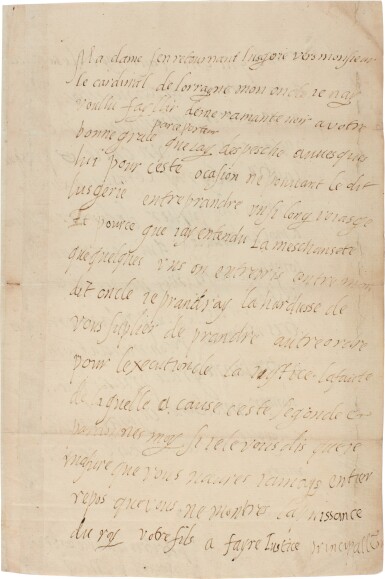Catherine de' Medici, Queen of France Letter signed ("Caterine"), as Queen Mother, to Raimond, Seigneur de Fourquevaux ("Monsieur de Fourquevaulx"), her son's Ambassador to Spain, 13 November 1568 in French, written to accompany a letter to him by her son Charles IX (1550-1574) about the state of affairs in the kingdom, in which Catherine asks for regular despatches to be sent directly to her, as often as possible, as she wishes to know all the latest developments, responding to the good wishes expressed by her son-in-law, Philip II of Spain, conveyed to her by "her cousin" the Duke of Alba; she adds that if the Prince of Orange proceeds with his rebellion against the Catholic Dominions in the Netherlands, then she is willing to give Alba assistance in suppressing it. 1 page, folio, countersigned by her secretary of state, [Nicolas] de Neufville, address panel on verso, Orleans, 13 November 1568 Catherine was the most powerful woman in 16th-century Europe, a celebrated icon of power, corruption and cruelty. She was the widow of King Henry II of France (reigned 1547-1559) and exerted great influence as the mother of the three kings who followed him: Francis II (acceded aged fifteen) Charles IX (aged ten) and Henry III (aged twenty-three). Among the crimes traditionally laid at her door is setting off the Wars of Religion in the Netherlands, discussed here, and the St Bartholomew Massacre of French Protestants in 1572, whilst Charles was King of France. The 3rd Duke of Alba (1507-1582) is notorious for his suppression of the rebellions in the Spanish Netherlands, led by William the Silent, Prince of Orange. Phillip II sent Alba to the Netherlands to put down the rising in 1567, supposedly at the instigation of Catherine herself, and on 5 June 1568 he personally supervised the execution of two rebel leaders, the Counts of Egmont and of Horn in Brussels.
Catherine de' Medici, Queen of France Letter signed ("Caterine"), as Queen Mother, to Raimond, Seigneur de Fourquevaux ("Monsieur de Fourquevaulx"), her son's Ambassador to Spain, 13 November 1568 in French, written to accompany a letter to him by her son Charles IX (1550-1574) about the state of affairs in the kingdom, in which Catherine asks for regular despatches to be sent directly to her, as often as possible, as she wishes to know all the latest developments, responding to the good wishes expressed by her son-in-law, Philip II of Spain, conveyed to her by "her cousin" the Duke of Alba; she adds that if the Prince of Orange proceeds with his rebellion against the Catholic Dominions in the Netherlands, then she is willing to give Alba assistance in suppressing it. 1 page, folio, countersigned by her secretary of state, [Nicolas] de Neufville, address panel on verso, Orleans, 13 November 1568 Catherine was the most powerful woman in 16th-century Europe, a celebrated icon of power, corruption and cruelty. She was the widow of King Henry II of France (reigned 1547-1559) and exerted great influence as the mother of the three kings who followed him: Francis II (acceded aged fifteen) Charles IX (aged ten) and Henry III (aged twenty-three). Among the crimes traditionally laid at her door is setting off the Wars of Religion in the Netherlands, discussed here, and the St Bartholomew Massacre of French Protestants in 1572, whilst Charles was King of France. The 3rd Duke of Alba (1507-1582) is notorious for his suppression of the rebellions in the Spanish Netherlands, led by William the Silent, Prince of Orange. Phillip II sent Alba to the Netherlands to put down the rising in 1567, supposedly at the instigation of Catherine herself, and on 5 June 1568 he personally supervised the execution of two rebel leaders, the Counts of Egmont and of Horn in Brussels.















Try LotSearch and its premium features for 7 days - without any costs!
Be notified automatically about new items in upcoming auctions.
Create an alert